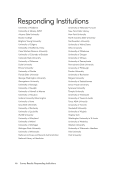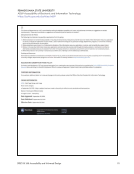3 SPEC Kit 358: Accessibility and Universal Design responses, or 88%) or specialized technology such as software and hardware (50 or 76%). Approximately 70 percent of the respondents said they would accommodate staff by creating flexible work schedules if needed. Specialized office spaces and lighting are provided by approximately half of the respondents (38 or 58%). Less frequently requested areas of accommodations include lactation space, sign language interpreters, ergonomic supports (footrests, wrist supports, etc.), and power-assisted doors. Half of the respondents answered a question about providing accommodations when recruiting potential library staff. Most of them indicated they would provide accommodations if asked and typically rely on candidates to request an accommodation. Some libraries take more proactive approaches, which include providing interview questions ahead of time, providing sign language interpreters, and asking about issues of transportation around campus and between buildings. Other interesting suggestions include making sure interviews were always taking place in an accessible room, asking candidates about dietary restrictions prior to arrival on campus, and notifying the candidate ahead of time about what accommodations are available while they are on campus. One comment seemed to capture the sentiment of many: “We’re not aware of fulfilling any accommodations during a recruiting process, though we would be happy to do so! Which raises the question of how we communicate our willingness to do this…” Publicizing and Coordinating Services Publicizing available accessibility services is done primarily through the library website (61 responses, or 94%) and through campus offices that support people with disabilities (60 or 92%). Library instruction, orientations, and social media are less frequently used to advertise the services and materials available for users with disabilities. Coordinating services for users with disabilities is primarily done by an ADA officer or disabilities coordinator in a central office of the parent organization (49 or 77%). About half of the respondents also reported having a library liaison, coordinator, or other designated person within the library to assist users or work with coordinating the services. Many times this position falls under a public services division or it is a public services staff. Additionally, 40 respondents (62%) indicated that their institution has a cross-departmental committee or group dedicated to addressing accessibility and services for patrons with disabilities. At 57 institutions (88%), interpreting disability laws is done by an ADA officer/disabilities coordinator in a central office on campus only 12 respondents (19%) reported that a library staff person would interpret laws. Staff and Training Thirty respondents identified a designated staff position that has responsibility for overseeing services for users with disabilities. The titles for these positions most frequently include such terms as accessibility specialist, ADA liaison, coordinator, library inclusion and accessibility librarian, manager, supervisor, or department head. Other positions that incorporate support for users with disabilities have more traditional library titles (i.e., research and instruction librarian, library assistant, etc.) Only seven positions spend more than 25% of their time on disability services and only two of those spend 100% of their allotted time overseeing these services. Most of the positions report to a department head a few report directly to an associate dean/university librarian. Ways in which library staff are trained in assisting users with disabilities primarily include webinars, staff attending conferences and acquiring information there, and hands-on training from a coordinator/liaison within the library. When it comes to training for assistive devices, most staff rely on manuals and/or webinars for information.




























































































































































